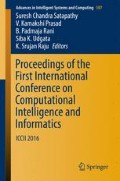Abstract
Feature Selection can be done in most of the medical domains to identify the most suitable features that result in the accuracy of classification and to reduce time of computation; as it works on reduced number of features. The nature of the problem domain and the design issues of soft computing methods used determines the effectiveness of feature selection methods. The study includes the feature selection using Genetic Algorithm (GA), to generate the best feature subset of WBCD breast cancer dataset. The features with the best fitness value are selected for classification. Classification is done using a guided approach called Support Vector Machine (SVM) along with some constraints to specify the performance measures of classification.
Access this chapter
Tax calculation will be finalised at checkout
Purchases are for personal use only
References
Eva Volna: Introduction to Soft Computing. 1st Edition, ISBN 978–87-403-0573-9 (2013).
Janmenjoy Nayak, Bighnaraj Nayak, Behra H. S.: A Comprehensive Survey on Support Vector Machine in Data Mining Tasks: Applications & Challenges. International Journal of Database Theory and Applications. Vol. 8, No. 1, pp. 169–186 (2015).
Zhang, G. P.: Neural Network for a Classification: a survey. IEEE transactions on Systems, Man and cybernetics-part C: Applications and Reviews, 30(4), 451–462 (2000).
Riyadh AbdEl-Salam Hassan, AbdEl-Fatah Hegazy, Amr Ahmed Badr: Optimize Support Vector Machine Classifier based on Evolutionary Algorithm for Breast Cancer Diagnosis. IJCSNS, Vol.10, No. 12, (2010).
Suresh Chandra Satapathy, Bhabendra Narayan Biswal, Siba. Udgata K., Mandal J. K.: Proceedings on 3rd International Conference on Frontiers of Intelligent Computing: Theory and Applications (FICTA). Vol. 1, Page 367 (2014).
Lavanya D., Usha Rani K.: A Hybrid Approach to Improve Classification with Cascading of Data Mining Tasks. International Journal of Application or Innovation in Engineering & Management (IJAIEM). Volume 2, Issue 1, January ISSN:2319-4847 (2013).
Lavanya, D., Usha Rani K.: Ensemble Decision Tree Classifier for Breast Cancer Data. International Journal of Information Technology Convergence and Services (IJITCS). Vol. 2, No. 1, February (2012).
Vijaya Sri K., Usha Rani K.: Neuro-Fuzzy Systems and Applications – A Review. International Journal Publications of Problems and Applications in Engineering Research. CSEA2012 Vol. 04, Special Issue 01; Pg. No’s 202–205, ISSN: 2230-8547; e-ISSN: 2230-8555. (2013).
Naga Rama Devi G., Usha Rani K.: Importance of Feature Extraction for classification of Breast Cancer Datasets – A Study. International Journal of Scientific and Innovative Mathematics Research (IJSIMR), Vol. 3, Special Issue 2, July, PP 763–768, ISSN 2347-307X (2015).
Naga Rama Devi G., Usha Rani K.: Evaluation of Classifier Performance using Resampling on Breast Cancer. International Journal of Science and Engineering Research, Vol. 6, Issue 2, February, ISSN 2229-5518 (2015).
Stefan Lessmann, Robert Stahlbock, Sven F. Crone: Genetic Algorithm for Support Vector Machine Model Selection. International Joint Conference on Neural Networks, Canada, July 16–21 (2006).
Omar S.Soliman, Eman AboElHamd: Classification of Breast Cancer using Differential Evolution and Least Square Support Vector Machines. International Journal of Emerging Trends and Technology in Computer Science, Vol. 3, Issue 2, April. (2014).
\Nithya, D., Suganya V., Saranya Irudaya Mary R.: Feature Selection using Integer and Binary Coded Genetic Algorithm to improve the performance of SVM Classifier. Journal of Computer Applications ISSN: 0974-1925, Vol. 6, Issue 3 (2013).
UCI Machine learning Repository, http://archive.ics.uci.edu/ml/.
Mangasarian O. L., Wolberg W. H.: Cancer diagnosis via linear programming. SIAM News, Volume 23, Number 5, September, pp 1 & 18 (1990).
Vijaya Sri K., Usha Rani K.: Ingenious Tools of Soft Computing. International Journal of Engineering Sciences Research-IJESR http://ijesr.in/ ACICE Vol. 04, Special Issue 01, Pg. No. 1305–1312, 2013 ISSN: 2230-8504; e-ISSN-2230-8512 (2013).
Author information
Authors and Affiliations
Corresponding author
Editor information
Editors and Affiliations
Rights and permissions
Copyright information
© 2017 Springer Science+Business Media Singapore
About this paper
Cite this paper
Kompalli, V.S., Kuruba, U.R. (2017). Combined Effect of Soft Computing Methods in Classification. In: Satapathy, S., Prasad, V., Rani, B., Udgata, S., Raju, K. (eds) Proceedings of the First International Conference on Computational Intelligence and Informatics . Advances in Intelligent Systems and Computing, vol 507. Springer, Singapore. https://doi.org/10.1007/978-981-10-2471-9_49
Download citation
DOI: https://doi.org/10.1007/978-981-10-2471-9_49
Published:
Publisher Name: Springer, Singapore
Print ISBN: 978-981-10-2470-2
Online ISBN: 978-981-10-2471-9
eBook Packages: EngineeringEngineering (R0)

